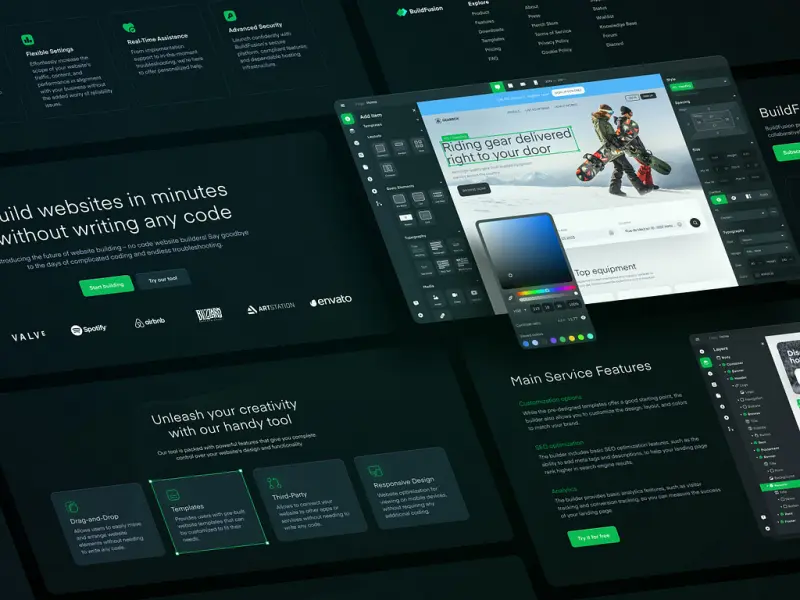Top 10 Trends for The Future of Web Development
- TECHVIFY Team
- 0 Comments
Businesses must keep up with the latest technologies and trends to stay competitive. The rise of progressive web apps, the need for voice search optimization, and a growing focus on accessibility and cybersecurity will influence the future of web development.
A SWEOR survey shows that 85% of users expect mobile-friendly websites, and 38% will abandon a site with poor design. Faster loading times also lead to higher conversion rates—potentially increasing by 7% for every second saved.
By following these trends, businesses can stay ahead, creating innovative and user-friendly applications. This blog’ll explore the top 10 web development trends from 2024 to further.
I. The State of Web Development
Web development trends encompass the latest practices, techniques, and technologies shaping how websites and web applications are designed, built, and optimized. These trends emerge in response to shifting user expectations, technological progress, and industry demands.
The Importance of Responsive and Mobile-First Design
Responsive design is a core trend in web development, ensuring websites function smoothly across various devices and screen sizes. With the growing use of smartphones and tablets, users expect websites to be accessible and fully functional on any device.
Another significant trend is the mobile-first design approach, where websites are initially designed for mobile devices and then scaled up for larger screens. This approach reflects the increasing dominance of mobile browsing and the need to prioritize the mobile user experience.
The state of web development
Leveraging Modern Frameworks and Performance Optimization
Modern frameworks and libraries like React, Angular, and VueJS have become popular because they streamline development and boost website performance. These tools provide developers with efficient methods to create dynamic and engaging web applications.
Optimizing website speed and performance is also crucial. Studies indicate that users are quick to abandon slow-loading websites, making performance optimization vital for a positive user experience and higher conversion rates. Techniques such as code minification, caching, and the use of content delivery networks (CDNs) help improve website speed.
II. The Future of Web Development: Key Trends to Watch
The future of web development is set to bring a host of exciting advancements that will transform how we interact with the web. Here are some of the key trends to keep an eye on:
1. Evolution of Frameworks and Libraries
Popular frameworks like React, Angular, and Vue.js will likely continue to evolve, offering advanced features, better performance, and improved developer tools. The shift towards component-based architecture will gain momentum, emphasizing the creation of reusable components that can be easily integrated across various applications. Additionally, frameworks for the future of website development are expected to prioritize developer experience (DX), providing more intuitive APIs, streamlined workflows, and robust debugging tools.
2. The Rise of WebAssembly
WebAssembly (Wasm) is emerging as a game-changer in web development. This low-level assembly language, designed to run in browsers at near-native speed, allows developers to write code in languages like C++ and Rust. The potential impact of WebAssembly is significant—it could enable the development of complex, high-performance applications directly in the browser, such as 3D games, video editing software, and high-quality graphics, previously achievable only on native platforms.
Future web development technologies
3. Growth of Progressive Web Apps (PWAs)
Progressive Web Apps (PWAs) are set further to blur the lines between web and native applications. By leveraging modern web technologies, PWAs offer features like push notifications, offline functionality, and home screen installation, providing users with a seamless, app-like experience. The benefits of PWAs are substantial—they enhance user engagement, reduce development costs by eliminating the need for separate native apps, and improve discoverability since they are easily indexed by search engines.
4. API-First Development Approach
The API-first development approach is gaining traction as it emphasizes building robust APIs as the foundation of web applications. This methodology enables faster development cycles, better scalability through modular design, and reusability across different applications. APIs also facilitate a consistent user experience across various platforms, including mobile apps, web interfaces, and wearable technologies, supporting an omnichannel approach to development.
5. Integration of AI and Bots
Artificial Intelligence (AI) is set to have a transformative impact on web development. AI can personalize user experiences by tailoring content and recommendations based on individual preferences and behavior. Smart chatbots, powered by AI, can handle user inquiries, automate repetitive tasks, and provide 24/7 customer support. Additionally, AI is streamlining content creation and generating text, images, and videos, making the process more efficient and scalable.
6. Increasing Popularity of Single Page Applications (SPAs)
Single Page Applications (SPAs) are becoming more popular due to their ability to deliver a seamless and highly responsive user experience. SPAs initially load a single HTML page, with content dynamically updated using JavaScript, eliminating the need for full-page reloads. This approach results in faster loading times and improved user engagement. Modern SPAs are also optimized for search engine optimization, ensuring better visibility and discoverability.
7. The Role of Motion UI
Motion UI is gaining traction as a powerful tool for creating engaging, intuitive, and user-friendly interfaces. This Sass library allows developers to add animations and transitions to enhance the user experience. By integrating simple CSS files with pre-made animations, Motion UI stands out as an easy-to-use technology that has proven effective in capturing user interest and attention. Since 2018, it has been instrumental in making websites and apps more visually appealing and interactive, helping them stand out in a competitive digital landscape.
These trends indicate the future of web apps are more dynamic, user-focused, and technologically advanced. Staying updated on these developments will enable developers and businesses to create innovative, efficient, and engaging web experiences.
Looking to Outsource Development?
Contact TECHVIFY – Vietnam’s Leading Offshore Software Development & Outsourcing Company, for consultation and development services.
8. The Growing Popularity of Static Website Generators
One of the most prominent trends in web development is the increasing use of Static Website Generators (SWGs). These tools offer a new approach to building faster, more secure, and easier-to-manage websites than traditional dynamic websites.
Static site generators work by pre-generating all HTML pages and assets during the build process rather than relying on a server to dynamically create HTML for each page request. This results in significantly quicker load times and enhanced scalability, as the website can be served directly from a Content Delivery Network (CDN) or a web server.
Popular static website generators like Jekyll, Hugo, and Gatsby have gained traction among developers who value simplicity, speed, and security. These tools are particularly well-suited for creating websites that don’t require frequent content updates or complex user interactions.
9. The Rise of No-Code/Low-Code Development Platforms
Another trend reshaping web development is the rise of no-code and low-code platforms. These tools empower users without programming expertise to create web applications through visual interfaces and drag-and-drop tools. The growing demand for custom web apps, combined with a shortage of skilled developers, has driven the adoption of these platforms.
No-code and low-code solutions offer a low learning curve, making them accessible to non-developers who want to build tech products. However, these platforms are not just for beginners; they also help developers rapidly prototype and scale projects.
According to Straits Research, the market for low-code platforms is expected to reach $148.5 billion by 2030. Popular solutions like WordPress, Wix, and Webflow allow users to develop websites without any prior coding knowledge, leveraging predefined templates and simple drag-and-drop functionality.
While no-code and low-code platforms offer significant advantages, they do not completely replace traditional coding. Instead, they serve as valuable tools that can help developers be more responsive and scale projects faster, particularly as we move into 2024.
Future of web apps
10. Increasing Focus on Data Compliance
Organizations must prioritize data compliance to safeguard customer information as data privacy concerns grow. With the rise in cyber-attacks, website owners are increasingly responsible for handling customer data securely. It’s essential to have a strategic incident management plan in place and ensure that teams are trained to prevent data leaks.
Regulations like the California Consumer Privacy Act (CCPA), which introduced new consumer rights as of January 1, 2023, highlight the importance of data compliance. These rights include the ability to limit the use and disclosure of sensitive personal information.
Different regions have varying data compliance standards. For example, websites targeting European Union audiences must adhere to GDPR regulations. Since the implementation of GDPR, over 340 fines have been issued for compliance failures, underscoring the importance of adhering to these laws.
Organizations must invest in data compliance to avoid long-term legal and financial consequences. Ensuring compliance with both local and global data protection laws is not just a trend but a necessity for any business operating online.
III. Emerging Challenges and Opportunities in Web Development
As web development continues to evolve, several challenges and opportunities are beginning to take shape that will influence the future of web development:
Adapting to Rapid Technological Advancements
The fast-paced evolution of web technologies presents a significant challenge for developers. With new tools, frameworks, and methodologies constantly emerging, staying up-to-date can be difficult. Continuous learning and skill enhancement will be essential for developers to adapt to these changes and maintain their competitive edge.
Navigating Ethical Dilemmas
As AI and machine learning become more integrated into web development, ethical considerations such as data privacy and user bias are becoming increasingly important. Developers and organizations must address these issues responsibly, ensuring that their applications uphold user rights and foster fairness.
Addressing the Skill Gap
The growing demand for web developers skilled in cutting-edge technologies could lead to a widening skills gap. As the industry advances, there may be a shortage of professionals with expertise in areas like AI, WebAssembly, and modern frameworks. To close this gap, educational institutions and training programs will need to evolve, offering updated curricula that equip aspiring developers with the necessary skills.
These challenges also offer opportunities for growth and innovation. By staying informed, investing in continuous education, and proactively addressing ethical issues, developers and businesses can position themselves for success in the rapidly changing landscape of web development.
IV. Future Predictions for Web Development
Building on the trends we’ve discussed, here’s a deeper look into the potential directions for the future of website development:
The Rise of JAMstack and Serverless Architecture
The JAMstack (JavaScript, APIs, Markup) is becoming increasingly popular, offering an approach that combines pre-rendered static sites with dynamic content delivered via APIs. This method aligns well with the serverless computing model, bringing several key advantages:
- Enhanced Performance: Static content delivers faster load times, providing users with a prompt and responsive experience.
- Scalability: The architecture easily handles high traffic volumes without the constraints of traditional server-based systems.
- Security: Static sites are inherently more secure than traditional server-side applications, reducing the risk of attacks.
- Reduced Development Costs: Serverless infrastructure eliminates the need for ongoing server maintenance, lowering overall costs for clients.
The Metaverse and Web 3.0
The concepts of the Metaverse—a persistent, immersive virtual environment—and Web 3.0, a decentralized web powered by blockchain technology, could profoundly influence web development. Web experiences in the future of web development might involve users owning digital assets, interacting in 3D environments, and seamlessly transitioning between platforms. To support these innovations, new frameworks and tools will be necessary to create secure, interactive experiences within the Metaverse.
Web development visualize
The Democratization of Web Development
The rise of low-code and no-code platforms is making web development more accessible to a broader audience. These tools allow individuals without formal coding training to create basic websites and applications, blurring the lines between citizen developers and professional developers. However, complex features and high-performance applications will still require the expertise of skilled programmers, ensuring that formal training remains valuable.
Ethical Considerations and User Privacy
As AI and machine learning become more integrated into web development, ethical considerations around user bias and data privacy will need to be prioritized. Developers must create algorithms that ensure fairness, non-discrimination, and transparency in decision-making processes. Additionally, with increasing regulations on user data privacy, developers will need to prioritize secure data storage and give users greater control over their personal information.
The Evolving Developer Landscape
The developer landscape is expected to evolve in tandem with these emerging trends. We may see a rise in specialized roles focused on areas like blockchain development, AI integration, and the creation of Metaverse experiences. Developers will need to continuously upskill and stay informed about the latest technologies to remain relevant in a rapidly changing industry.
Conclusion
As mobile usage continues to rise, businesses must prioritize responsive design and performance optimization to meet user expectations. The adoption of modern frameworks, static website generators, and no-code/low-code platforms will further drive innovation, making web development more efficient and accessible.
However, staying competitive in this fast-paced environment requires more than just adopting new technologies. It involves understanding and navigating emerging challenges such as data compliance, ethical considerations, and the growing skills gap in the industry.
If you’re looking to leverage these trends and stay ahead of the curve, TECHVIFY is here to help. Our team of experts is ready to provide you with a free consultation and customized development services tailored to your business needs. Contact us today to start your journey toward building cutting-edge web solutions that drive success.
TECHVIFY – Global AI & Software Solutions Company
For MVPs and Market Leaders: TECHVIFY prioritizes results, not just deliverables. Reduce time to market & see ROI early with high-performing Teams & Software Solutions.
- Email: [email protected]
- Phone: (+84)24.77762.666









